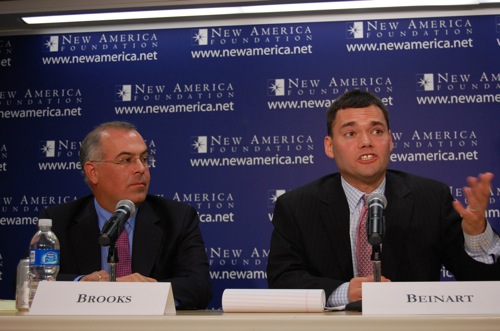Feedback (7)
By:
October 29, 2010

FEED (October 29, 1999): Peter Beinart, the editor-elect [Beinart left TNR in 2006 — ed.] of The New Republic, is “a journalist’s journalist and an intellectual’s intellectual, at once at home with grand ideas and alert to stubborn little facts.” So enthuses head honcho Martin Peretz [currently in the news for writing a controversial blog post — ed.] in the magazine’s 85th anniversary issue this week.
[Seventh in a series of items originally published by the now-defunct website FEED.]
Clearly the “stubborn little facts” bit is a dig at ex-editor Michael Kelly [Kelly died in 2003 while covering the invasion of Iraq — ed.], on whose editorial watch Stephen Glass pushed the epistemological envelope. As for the rest, perhaps the 28-year-old Beinart is being compared with Walter Lippmann, the Young Intellectual who helped found TNR in his late 20s. So what exactly is Peretz suggesting about the magazine’s intellectual direction at 85?

Only Leon Wieseltier Knows! Why else would the Hades-like lord of the back of the book choose to publish, in this particular issue, a long meditation by TNR senior editor James Wood [in 2007 Wood became a staff writer at The New Yorker — ed.] on The Myth of Sisyphus, an essay Albert Camus wrote at the age of 28?
Camus was born the year Lippmann published his first book, but though they belong to different generations, the similarity between the two young intellectuals is striking. They shared an obsession with “drift,” Lippmann’s term for the tendency of people to move aimlessly through life. Both men believed that the antidote to drift is the substitution of conscious intention for unconscious striving; only by taking personal responsibility for our choices, they insisted, can we become fully human.
But here they part company. Lippmann wanted to substitute “mastery” for the conflict and disorder of modern industrial society — which helps explain TNR’s enduring belief in the possibilities of social control, and its longing for an instrumental state run by experts. (John Reed poetically described Lippmann as one “who wants to make the human race, and me,/March to a geometric QED.”) Camus, however, was no technocrat. In The Myth of Sisyphus he describes the desire for a world in which rationality, justice, and order prevail as nothing but “nostalgia.”

Wood’s essay concludes that the myth of Sisyphus — who Camus suggested was liberated from his rock-pushing prison by recognizing its absurdity — is “movingly useless” as a metaphor for how to live. Had Camus ever read The New Republic, he would assuredly have responded in kind. “Before encountering the absurd, the everyday man lives with aims, a concern for the future or for justification,” he wrote. “But after the absurd, everything is upset.” Unlike Lippmann, who would have counseled Sisyphus to leave the boulder-management to the experts, Camus urged us to recognize that “chain of daily gestures” that constitutes a life of unwitting repetition, and to rebel against it. How? By opposing the world’s inherent meaninglessness, not with “mastery,” but with “our revolt, our freedom, and our passion.”

“Change is constant in the world of Peretz,” Michael Kelly has said of his former boss. But in recent years there has been a horribly comic repetitiveness to The New Republic’s masthead follies; Beinart will be the sixth editor of that magazine in just a decade. Drift, it seems, has firmly established itself in the very place where Lippmann once reigned. Perhaps, then, instead of blaming editor after editor for TNR’s accelerating loss of journalistic and liberal credibility, Peretz should recognize the absurdity of life, take responsibility for it (without trying to “master” it), and urge his new editor to do the same. Now, that might result in a magazine worth reading.
Launched in May 1995, the web magazine FEED — which helped launch the careers of Steven Johnson, Steve Bodow, Keith Gessen, Joshua Micah Marshall, Erik Davis, Christine Kenneally, Alex Abramovich, Chris Lehmann, Sam Lipsyte, Alex Ross, Clay Shirky, Ana Marie Cox, and many others, including yours truly — went offline in the summer of 2001. In June 2010, its archives were made available. This is the seventh in a series reprinting a few of my own favorite FEED Dailies.
